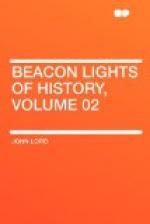Josiah, who was thoroughly aroused by “the words of the book,” and its denunciations of the wrath of Jehovah upon the people if they should forsake his ways, in spite of the secret opposition of the nobles and priests, zealously pursued the work of reform. The “high places,” on which were heathen altars, were levelled with the ground; the images of the gods were overthrown; the Temple was purified, and the abominations which had disgraced it were removed. His reforms extended even to the scattered population of Samaria whom the Assyrians had spared, and all the buildings connected with the worship of Baal and Astaroth at Bethel were destroyed. Their very stones were broken in pieces, under the eyes of Josiah himself. The skeletons of the pagan priests were dragged from their burial places and burned.
An elaborate celebration of the feast of the Passover followed soon after the discovery of the copy of the Law, whether confined to Deuteronomy or including other additional writings ascribed to Moses, we know not. This great Passover was the leading internal event of the reign of Josiah. Having “taken away all the abominations out of all the countries that belonged to the children of Israel,” even as the earlier keepers of the Law cleansed their premises, especially of all remains of leaven,—the symbol of corruption,—the king commanded a celebration of the feast of deliverance. Priests and Levites were sent throughout the country to instruct the people in the preparations demanded for the Passover. The sacred ark, hidden during the reigns of Manasseh and Amon, was restored to its old place in the Temple, where it remained until the Temple was destroyed. On the approach of the festival, which was to be held with unusual solemnities, great multitudes from all parts of Palestine assembled at Jerusalem, and three thousand bullocks and thirty thousand lambs were provided by the king for the seven days’ feast which followed the Passover. The princes also added eight hundred oxen and seven thousand six hundred small cattle as a gift to priests and people. After the priests in their white robes, with bare feet and uncovered heads, and the Levites at their side according to the king’s commandment, had “killed the passover” and “sprinkled the blood from their hands,” each Levite having first washed himself in the Temple laver, the part of the animal required for the burnt-offering was laid on the altar flames, and the remainder was cooked by the Levites for the people, either baked, roasted, or boiled. And this continued for seven days; during all the while the services of the Temple choir were conducted by the singers, chanting the psalms of David and of Asaph. Such a Passover had not been held since the days of Samuel. No king, not even David or Solomon, had celebrated the festival on so grand a scale. The minutest details of the requirements of the Law were attended to. The festival proclaimed the full restoration of the worship of Jehovah, and kindled enthusiasm for his service. So great was this event that Ezekiel dates the opening of his prophecies from it. “It seems probable that we have in the eighty-fifth psalm a relic of this great solemnity.... Its tone is sad amidst all the great public rejoicings; it bewails the stubborn ungodliness of the people as a whole.”




